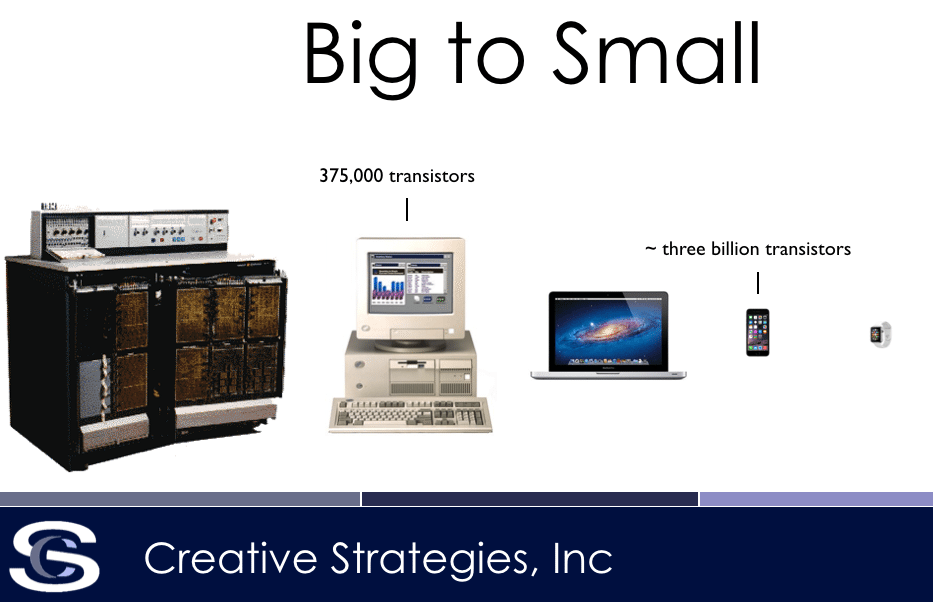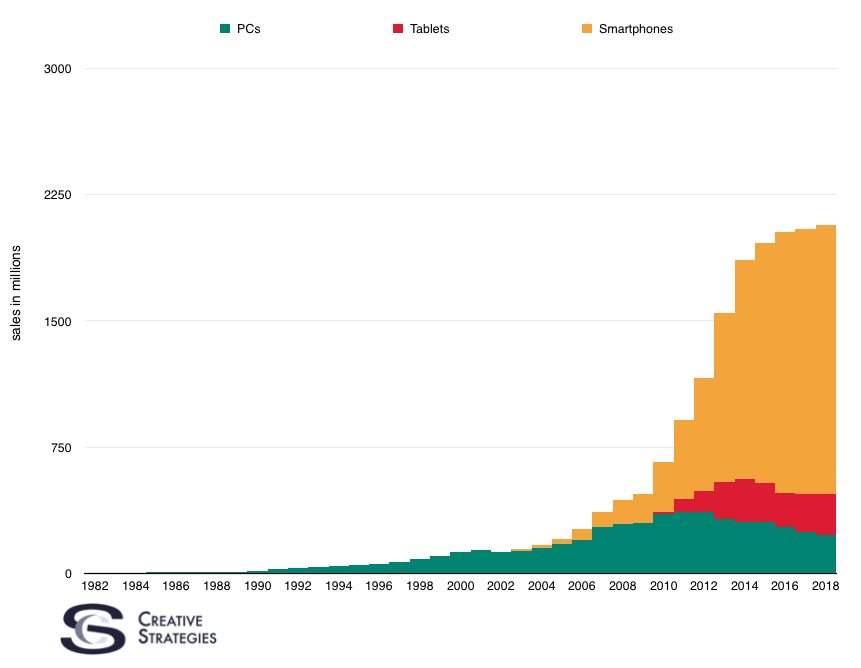As I look at the last thirty years of the technology industry, a few important observations stand. Allow me to share some visuals from a presentation I gave a few years ago at the Postmodern Computing Summit.
The first significant observation is that computers are getting smaller. The advancements being made in microprocessors are allowing us to take supercomputers from form factors that once fit in a closet to ones that now fit in our pockets and, in the future, be worn on our bodies.
The second observation is what that computational curve of processing evolution enabled. Each step function in computational power brought with it a step function in ease of use and eliminated layers of complexity which existed previously.
In software, we went from text-based user interfaces to more visual ones and, each step of the way, computers were embraced by more and more people. Each step function enabled new step functions in scale as easier user interfaces, smaller more personal form factors, and lower prices, enabled what I call “Computing’s S-curve”. This curve, and perhaps all the step functions I mentioned, culminated with the smartphone which has brought computing to people who have never owned computers before. Now, roughly 2.5 billion people have pocket computers.
We remain on a journey to connect the unconnected. We still have rouhgly three billion people on the planet who have yet to get a smartphone. Many of those people can and will benefit from the value of the internet and instant communication. We still need to continue to make cellular plans more affordable for those making less than $5 a day. For this same group, we need to solve battery problems so they don’t have to charge it every day because that costs money they need for other things like food. Another key development needed to connect the unconnected is language support. This is where I think we are on the cusp of another elimination of complexity in computer user interfaces as we embrace voice-based UIs.
The Voice UI will play an important role in making computers even easier to use than they are today. While the screen is not going away, I do believe voice will become a key way to interact with our smart devices and get more value from them. In the case of rural parts of the world where their languages are not yet supported (or even if it is, they may not be able to read), they will be able to speak to it. Machine learning advances will likely help us advance training machines to learn new languages which, in turn, will hopefully help our smart devices support hundreds of languages and dialects not yet supported.
Watch kids who can’t read yet use Siri or an Amazon Echo to search the internet, play videos, and more. Similarly, as touch-based interfaces made it possible for kids to engage with computers, voice will open up even more possibilities and depth to their computing experience.
What’s interesting is voice will not open up new computing possibilities for everyone, even people with a strong grasp of computers today. I’d posit that, for a normal human, not a hardcore techie or early adopter, many of them do not get the most out of the computers they have on their laps or in their pockets. It sounds crazy to say this but even our smartphones still overserve the basic needs of billions of people. But the question in my mind is, how can we get these people doing more with their smart devices? I believe voice-based interfaces will play a key role in that experience.
Imagine being able to use your voice while looking at a screen to edit video, photos, create visual representations of data and, more importantly, have the computer engage back with you to help you learn, discover, and do more.
The next step function of computing, which will eliminate another layer of complexity, will come as we build computers that can see and hear. We are in the early stages of this right now as the machine learning era is taking off. That will lead us to have some of the most powerful and interactive computers with us at all times as nearly everyone on the planet will have an incredibly smart personal assistant.




Excellent article! We will be linking to this particularly great article on our website. Keep up the good writing.
Thank you for great information. I look forward to the continuation.
You’re so awesome! I don’t believe I have read a single thing like that before. So great to find someone with some original thoughts on this topic.